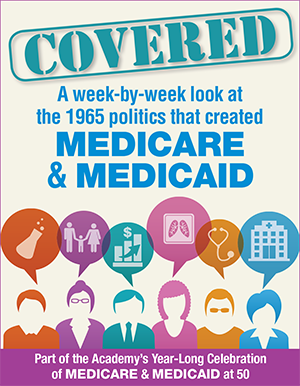Bob Rosenblatt, Special Correspondent
Welcome to Covered: A Week-by-Week Look at the 1965 Politics that Created Medicare and Medicaid. Bob Rosenblatt, a Senior Fellow at the National Academy of Social Insurance, former Los Angeles Times Washington correspondent, and editor of the website HelpWithAging will blog on the maneuvers that led to the enactment of Medicare and Medicaid on July 30th, 1965 the first major expansion of U.S. social insurance to health care.
Key House Committee Considers Hospital Care for the Elderly
January 27, 1965
By Bob Rosenblatt, Special Correspondent
Social Security would be expanded to provide more than 16 million people over the age of 65 with hospital care under a Johnson Administration proposal now being discussed in closed-door meetings of the House Ways and Means Committee.
This latest proposal is driven by the rising cost of health care, which is causing more people to enroll in state welfare programs. “Over the past several years, a large and growing proportion of those applying for public aid has been forced to do so only because they cannot meet their health costs,” Anthony J. Celebrezze, Secretary of Health, Education and Welfare, told the committee on January 27th. Transcripts were made available to this blog by committee sources.
Rep. Thomas B. Curtis (R-MO) questioned the need for the program. He pointed out that health insurance individual policies are “one of the most rapidly growing fields that we have.” More than half of people over 65 have coverage, he said. People who are able to buy this insurance “tend to have higher incomes and be in better health,” responded Social Security Commissioner Robert Ball, who testified for the Administration.
Another skeptical member of the committee, Rep. A. S. Herlong Jr. (D-Fla), wondered if the Administration wants the legislative proposal expanded to cover doctors’ bills. “Is it ever anticipated by you or anyone else that you know of in your department that we are going to increase the hospital benefits for the people here to include medical care as well as hospital care?” No, responded HEW Deputy Secretary Wilbur Cohen, the point man for the White House in negotiating with Congress on this legislation. “As far as I know, speaking for myself, Secretary Celebrezze, and Mr. Ball, the Administration has no intent to expand the scope of this to cover such things as physician services.”
Cohen’s assurances to the committee seem certain to stir confusion in Congress. He has been a long-time advocate for expanding government-financed health care, including coverage for visits to a doctor’s office. Cohen’s assertion that the Johnson Administration isn’t thinking about this will only antagonize liberal Democrats and some moderate Republicans who might be open to the idea. And it will strengthen the hand of those in both parties who don’t want any change in the current system of care delivered by doctors. If the Administration changes its approach, these members may feel they have been deceived.
Approximately 60 percent of people who qualify for Old Age Assistance (OAA) and Medical Aid for the Aged (MAA) “do so because of health cost,” said Celebreeze. Their medical bills reduce their income enough for them to qualify for welfare. More than a third of money going to public assistance programs is consumed by health care spending, according to Celebrezze.
Though the rising cost of health care is a problem for people of all income levels who lack insurance, people past age 65 on average have lower incomes than the general population; they also have medical costs that are on average twice as high as individuals under the age of 65.
The Johnson Administration has responded by seeking Congressional approval for a new health program, similar to the one that was considered but rejected by Congress last year. The bill under discussion in this week’s committee hearings would provide:
- 60-days in the hospital, with the patients paying a deductible for the first day equal to the average cost of a day in the hospital (approximately $40);
- Post-hospital care for up to 60-days that would cover convalescence and rehabilitation in a less expensive facility; and
- Up to 240 home care visits for a person who is homebound.
The proposed legislation would not cover care in nursing homes and it would not cover visits to either a doctor’s office or care provided by doctors outside the hospital. The American Medical Association has long opposed proposals for the federal government to cover medical care outside of the hospital.
The program would be funded by a tax on employees’ salaries, with an equal share paid by the worker and the employer. The tax would be an additional 6/10 of 1 percent of earnings of up to $5,000 a year in 1966, with gradual increases rates in 1967 and 1968, before leveling off at 9/10 of 1 percent of wages in subsequent years. A worker earning $5,000 in 1966 would, for example, pay an additional $30 per year in taxes; their employer would also pay an additional $30 per year.
►See the next post in the COVERED series: “AMA Blasts Administration’s Medicare Proposal,” February 6, 1965
► Learn more about the Academy’s celebration of 50th anniversary of the enactment of Medicare and Medicaid

